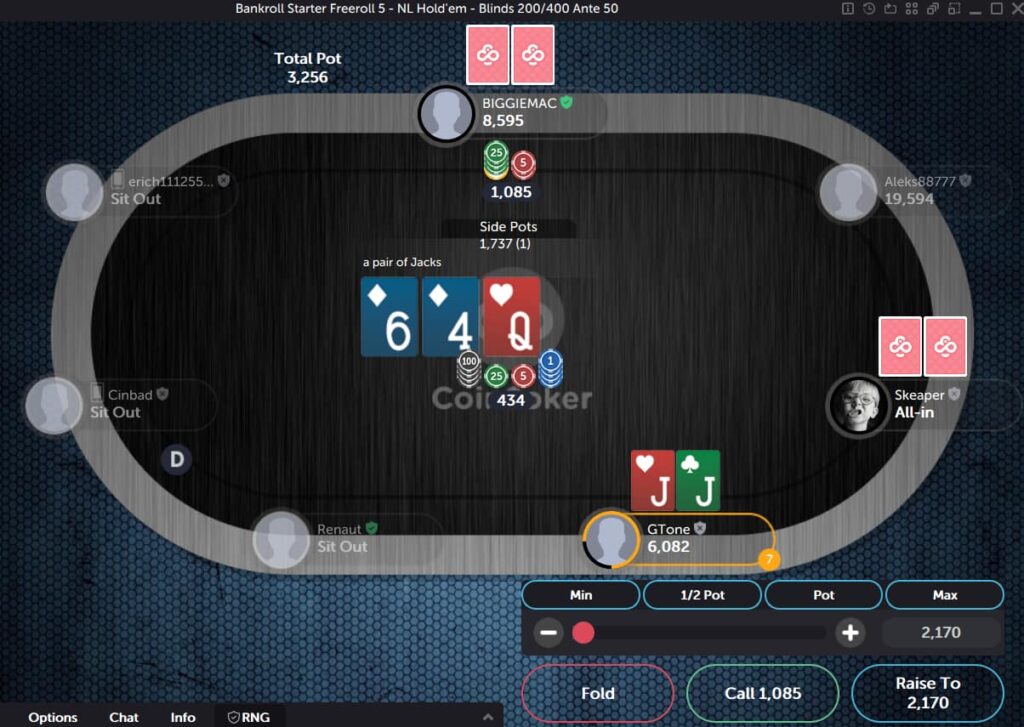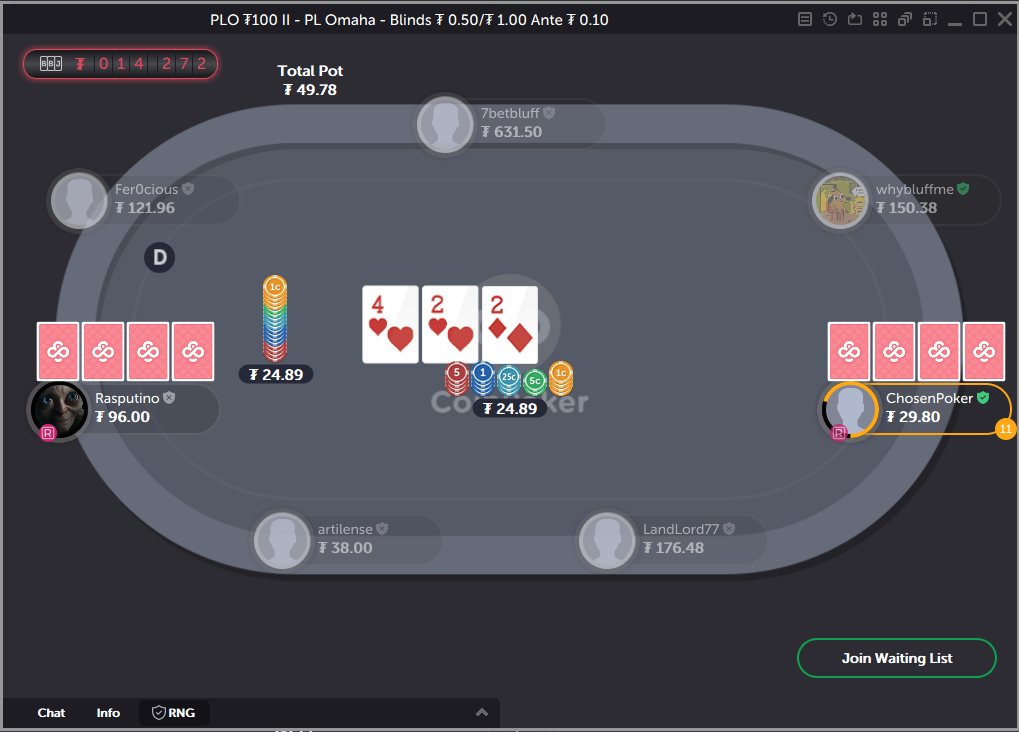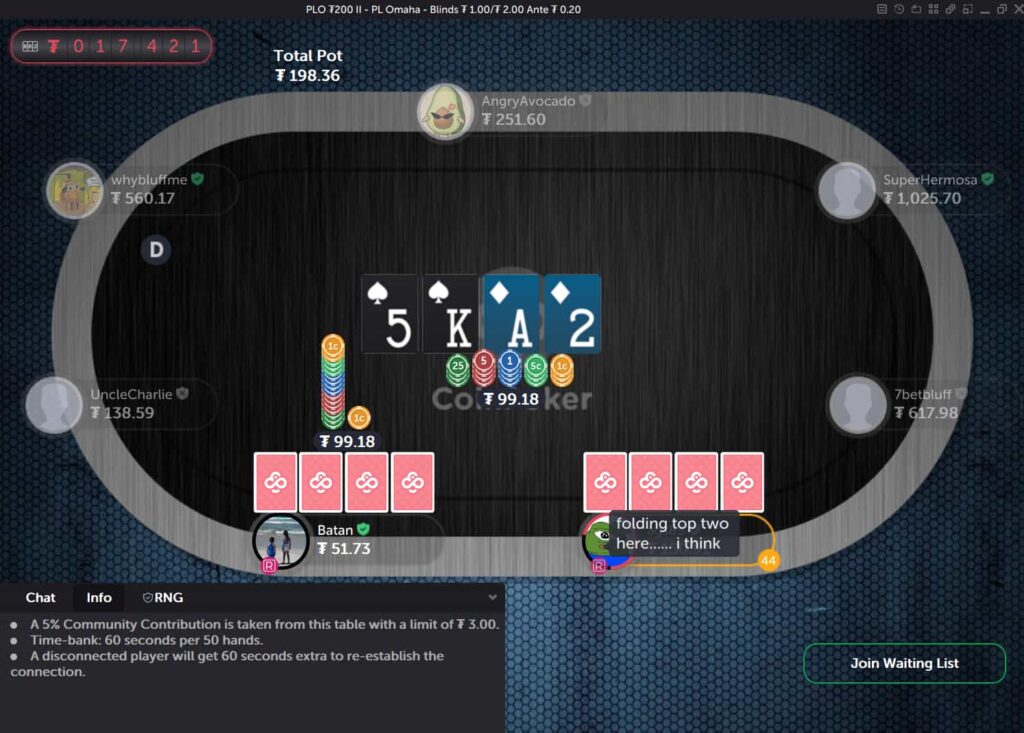Last Updated: 6 November 2025
C-Bet Poker Strategy: When to Fire the Continuation Bet
C bet poker strategy is vital, but the continuation bet is misunderstood by many. Learn about c bets here and use them effectively in your games.
StrategyA C-bet poker strategy focuses on continuation betting, a key post-flop play for pre-flop aggressors. On this page, you will learn what a continuation bet is, why players use it, and how to choose the right spots to bet or check. We’ll also cover benefits, risks, and advanced concepts like delayed c-bets to equip you to make smarter decisions at the table.
What is a Continuation Bet in Poker?
A continuation bet in poker, or c-bet, occurs when you follow up a pre-flop raise with a bet on the flop, whether or not you have connected with the board. It is one of poker’s most important betting strategies, a post-flop move to maintain initiative and apply pressure to opponents.
C-bets are versatile beasts! When you hit the flop, they help build the pot with strong hands. When you miss, they can win the pot immediately through fold equity. Using c-bets effectively requires understanding board texture, position, and your opponents’ likely holdings.

A Simple Continuation Bet Example
Let’s break down a typical c-betting scenario you might encounter at the tables.
- You’re playing in a $1/$2 cash game.
- You raise to $6 from the middle position with Q♠J♠.
- The big blind calls, creating a $13 pot.
But now, the flop comes 8♣4♥2♦. This is a board that completely misses your hand but also likely misses your opponent’s range.
When checked to, you make a c-bet of $8, representing a strong hand like pocket pairs or even ace-high. This bet accomplishes multiple objectives: it can win the pot immediately when your opponent has nothing (which happens frequently), it builds the pot if you happen to hit on later streets, and it maintains your table image as an aggressive, competent player.
Consider another example: You raise pre-flop with A♥K♦ and face two callers. The flop brings 7♠5♣2♦. Despite missing completely, this dry, uncoordinated board presents an excellent c-betting opportunity because it’s unlikely to have helped your opponents’ calling ranges. Your ace-high might even be the best hand, making this both a semi-bluff and a thin value bet.
What is a Good C-Bet Percentage?
There isn’t one perfect number for how often to c-bet, but most solid players land somewhere between 50% and 70%. The right percentage depends on various factors, such as position, the texture of the board, and the tendencies of your opponents.
If you’re betting every flop, you’re likely bluffing too much and getting called down by players who notice. If you’re only betting when you hit, you’re leaving money on the table by missing simple steal spots. The best approach to determining a good C-bet percentage is to review your hand history and make adjustments to your game to improve results.
Understanding C-Bet Frequency
Your c-bet frequency is how often you follow up your preflop raise with a bet on the flop. In position, you can get away with betting more often because you see what your opponent does before acting again. Out of position, it’s better to be selective and focus on boards that clearly favor your hand range.
Let’s go over a few c-bet situation examples:
- On dry boards like A-7-3 rainbow, c-bet often, around 65–70%
- On wet, connected boards like 9-8-7 two-suited, c-bet less, around 40–50%
- In heads-up pots, lean toward the higher end or even towards 75% against passive opponents
- In multiway pots, stay selective and focus on strong hands or solid draws.
Once you understand how often to fire a continuation bet, the next step is knowing why to do it.
Why Do Poker Players C Bet: Benefits of C-Betting
Continuation betting helps win pots without strong hands, keeps opponents guessing, and allows control over the flow of play. These benefits make c-betting a key part of a savvy poker player’s strategy.
Adapt your c-betting strategy based on opponent tendencies. Against tight players, you can c-bet more frequently and use smaller sizes effectively. Include more bluffs in your range, but avoid multi-street bluffs as these opponents often play straightforwardly.
Loose players require a different approach. Reduce your bluffing frequency and size larger with your value hands. Focus on strong hands that can withstand resistance, as these opponents tend to call and raise more frequently.
Effective stacks significantly influence optimal c-betting strategy. With deep stacks over 100 big blinds, you can include more semi-bluffs in your range and plan for multiple streets of betting. Consider using delayed c-bets more often, and don’t be afraid to size larger with your value hands.
Short stacks under 50 big blinds require a more straightforward approach. Focus on immediate fold equity and reduce your bluffing frequency. Size your bets to set up commitment decisions, and look to value bet thinner than usual given the reduced stack-to-pot ratios.
No content available.
When Should You C-Bet in Poker?
The best c-bet spots share a few common traits. Generally, you want position, a board that favors your range, and opponents who can fold. Here are the main situations where a continuation bet is likely to be profitable:
- When you are in position
- When the board texture is favorable
- When you have a strong hand
- When opponents are tight or passive
- When using a delayed c-bet
Adapt your c-betting strategy based on opponent tendencies. Against tight players, you can c-bet more frequently and use smaller sizes effectively. Include more bluffs in your range, but avoid multi-street bluffs as these opponents often play straightforwardly.
Loose players require a different approach. Reduce your bluffing frequency and size larger with your value hands. Focus on strong hands that can withstand resistance, as these opponents tend to call and raise more frequently.
Effective stacks significantly influence optimal c-betting strategy. With deep stacks over 100 big blinds, you can include more semi-bluffs in your range and plan for multiple streets of betting. Consider using delayed c-bets more often, and don’t be afraid to size larger with your value hands.
Short stacks under 50 big blinds require a more straightforward approach. Focus on immediate fold equity and reduce your bluffing frequency. Size your bets to set up commitment decisions, and look to value bet thinner than usual given the reduced stack-to-pot ratios.
No content available.

When Should You Not C-Bet in Poker?
C-betting every flop will get you into trouble fast. There are times when dabbing the brakes and checking is the smarter play. Here are the main situations where you should think twice before firing a continuation bet:
- When facing opponents who don’t fold
- When you are out of position
- When you’re facing multiway pots
- When you have a bad board
Adapt your c-betting strategy based on opponent tendencies. Against tight players, you can c-bet more frequently and use smaller sizes effectively. Include more bluffs in your range, but avoid multi-street bluffs as these opponents often play straightforwardly.
Loose players require a different approach. Reduce your bluffing frequency and size larger with your value hands. Focus on strong hands that can withstand resistance, as these opponents tend to call and raise more frequently.
Effective stacks significantly influence optimal c-betting strategy. With deep stacks over 100 big blinds, you can include more semi-bluffs in your range and plan for multiple streets of betting. Consider using delayed c-bets more often, and don’t be afraid to size larger with your value hands.
Short stacks under 50 big blinds require a more straightforward approach. Focus on immediate fold equity and reduce your bluffing frequency. Size your bets to set up commitment decisions, and look to value bet thinner than usual given the reduced stack-to-pot ratios.
No content available.
Risks of the Continuation Bet
While c-betting can be highly effective, it comes with several potential pitfalls that players must carefully consider:
- Burning Money: C-betting too frequently, especially against observant opponents who pick up on your patterns, can lead to significant losses through failed bluffs and getting called down light.
- Getting Check-Raised: Aggressive players might exploit predictable c-betting by check-raising with both value hands and bluffs, putting you in difficult situations with marginal holdings.
- Multi-Way Pot Dangers: C-betting into multiple opponents dramatically increases your risk as you need to get through multiple players to win the pot immediately.
- Stack Commitment: Poor c-bet sizing can lead to awkward stack-to-pot ratios on later streets, potentially forcing you to make tough decisions with marginal hands.
- Board Texture Mistakes: C-betting into boards that favor your opponent’s range can be costly, especially when they have strong drawing hands or hidden monsters.
How to Defend Against C-Bets?
Knowing how to handle c-bets is just as important as knowing when to make them. After all, you don’t want to fold every time someone fires at the flop.
Pay attention to how your opponent bets, how the board looks, and how often they c-bet. Then, you can start fighting back in the right spots. Keep your defense balanced, though, and you’ll be tough to play against while stopping aggressive players from running over you.
Adapt your c-betting strategy based on opponent tendencies. Against tight players, you can c-bet more frequently and use smaller sizes effectively. Include more bluffs in your range, but avoid multi-street bluffs as these opponents often play straightforwardly.
Loose players require a different approach. Reduce your bluffing frequency and size larger with your value hands. Focus on strong hands that can withstand resistance, as these opponents tend to call and raise more frequently.
Effective stacks significantly influence optimal c-betting strategy. With deep stacks over 100 big blinds, you can include more semi-bluffs in your range and plan for multiple streets of betting. Consider using delayed c-bets more often, and don’t be afraid to size larger with your value hands.
Short stacks under 50 big blinds require a more straightforward approach. Focus on immediate fold equity and reduce your bluffing frequency. Size your bets to set up commitment decisions, and look to value bet thinner than usual given the reduced stack-to-pot ratios.
No content available.
How to Build a Balanced C-Bet Strategy
A solid c-bet strategy balances value hands with smart bluffs and consistent betting frequencies. When your opponents can’t easily tell whether you’re strong or weak, your overall range becomes much harder to play against. Stay focused, as building this balance requires awareness of board texture, opponent type, and position.
Adapt your c-betting strategy based on opponent tendencies. Against tight players, you can c-bet more frequently and use smaller sizes effectively. Include more bluffs in your range, but avoid multi-street bluffs as these opponents often play straightforwardly.
Loose players require a different approach. Reduce your bluffing frequency and size larger with your value hands. Focus on strong hands that can withstand resistance, as these opponents tend to call and raise more frequently.
Effective stacks significantly influence optimal c-betting strategy. With deep stacks over 100 big blinds, you can include more semi-bluffs in your range and plan for multiple streets of betting. Consider using delayed c-bets more often, and don’t be afraid to size larger with your value hands.
Short stacks under 50 big blinds require a more straightforward approach. Focus on immediate fold equity and reduce your bluffing frequency. Size your bets to set up commitment decisions, and look to value bet thinner than usual given the reduced stack-to-pot ratios.
No content available.
C-Bets in Cash Games & Tournaments
The approach to c-betting changes a bit from these two formats. In cash games, stacks are deeper, and you can always reload, so more c-bets are generally solid play. For a best practice c-betting tournament strategy, remember that chips are worth more because you can’t just buy back in (unless it’s a rebuy). So, be very selective when continuation betting in MTTs.
| Situation | Cash Games | Tournaments |
| Stack Depth | Deep, 100bb+ | Often short, 20 – 60bb |
| Goal | Build pots and extract value | Preserve chips, apply selective pressure |
| Frequency | Higher, balanced range | Lower, selective range |
| Risk | Can reload chips | Bust means elimination |
| Adjustments | Use smaller sizes, plan for multiple streets | C-bet less often, focus on high-equity hands |
Advanced C-Bet Concepts
As you develop your poker c-bet strategy, you’ll need to consider multiple factors. Once you’ve mastered the basics, you can incorporate more advanced factors into your decision-making process.
Adapt your c-betting strategy based on opponent tendencies. Against tight players, you can c-bet more frequently and use smaller sizes effectively. Include more bluffs in your range, but avoid multi-street bluffs as these opponents often play straightforwardly.
Loose players require a different approach. Reduce your bluffing frequency and size larger with your value hands. Focus on strong hands that can withstand resistance, as these opponents tend to call and raise more frequently.
Effective stacks significantly influence optimal c-betting strategy. With deep stacks over 100 big blinds, you can include more semi-bluffs in your range and plan for multiple streets of betting. Consider using delayed c-bets more often, and don’t be afraid to size larger with your value hands.
Short stacks under 50 big blinds require a more straightforward approach. Focus on immediate fold equity and reduce your bluffing frequency. Size your bets to set up commitment decisions, and look to value bet thinner than usual given the reduced stack-to-pot ratios.
C-betting into multiple opponents requires significant strategic adjustments. You’ll need to tighten your c-betting range considerably and focus primarily on strong value hands and premium draws. Increase your sizing to around 70-80% of the pot to account for multiple opponents. Bluffing becomes significantly less profitable as you need to get through multiple players to win immediately.
For example: You raise A♦K♦ from middle position and get three callers. The flop comes J♠7♠4♣. Despite having overcards and backdoor possibilities, this spot usually warrants a check because you need to get through multiple players to win immediately.

Master Your C-Bet Strategy Today
Mastering c-bets transforms your poker game from passive to powerful. You’ve learned how board textures influence your decisions, when position dictates aggression, and how stack depths affect your strategy.
Ready to implement these c-betting concepts at the tables? Join us at CoinPoker where you’ll find the perfect environment to practice and refine your skills. Whether you prefer tournaments or cash games, our platform offers:
FAQs
C-betting frequency typically ranges from 50-70% in heads-up pots, adjusting based on board texture, position, and opponent tendencies.
Standard c-bet sizing ranges from 50-75% of the pot, with larger bets on wet boards and smaller bets on dry boards.
No, mixing in checks with strong hands protects your checking range and prevents exploitation.
Avoid c-betting on very coordinated boards, against multiple opponents, or when out of position against aggressive players.
Defend by calling with strong draws and pairs, raising with nutted hands and strategic bluffs, and adjusting based on opponent tendencies and board texture.
Explore More
Announcements
Read recent announcements from CoinPoker about new games, ambassadors, and changes to our platform.
8 PostsGuides
The go-to resource for mastering poker with expert tips and strategies. Whether you're a beginner or a pro, our guides will elevate your skill level.
55 PostsNews
Find the latest poker news from CoinPoker, plus our latest CoinPoker Weekly and Monthly Newsletters. Updates about games, promotions and other exciting crypto news.
83 PostsPromotions
Find the latest coinpoker promotions here. Explore the crypto poker world with the best poker promotions available.
1 Post















